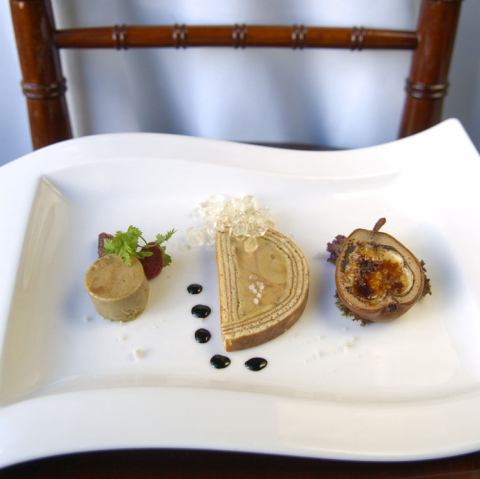



Yields 25-30 servings
Baumkuchen
1 tablespoons unsalted butter, cold
1 tablespoon all-purpose flour
8 ounces unsalted butter, warm and melted
10 each eggs, separated, yolks at kitchen temperature, whites kept cold
4 ounces granulated sugar
6 ounces all-purpose flour
Procedure
Set your oven to broil. On a flat half-sheet pan, evenly spread the 1 tablespoon cold butter with your fingertips. Sprinkle with the 1 tablespoon of flour and shake to coat evenly; knock off any excess. Set aside.
In three medium-size (1G capacity) nonreactive mixing bowls, place the butter, yolks, and egg whites each in a separate bowl. Keep the bowl of whites in the refrigerator and make sure the yolks have been sitting out long enough (covered with plastic wrap so they don?t form a skin) to come up to kitchen temperature; otherwise, they will cool down the butter too much and you will overwork the batter incorporating the whites.
Working quickly, add the sugar to the yolks and whisk until the mixture is pale and forms ribbons. Whisk the warm butter into the mixture until homogenous, then add the flour all at once and fold in gently with a rubber spatula until just combined. Set aside in a warm place.
Clean your whisk and dry it thoroughly; any residual fat left on it will ruin your meringue. Remove the whites from your refrigerator and whip to medium peaks. In three equal additions, add your whites to the above mixture and fold in as gently as possible with a rubber spatula. Continue until all the whites are incorporated and the batter is silky and homogenous. Be careful not to overwork it.
Using an offset pastry spatula, spread one fifth of your batter in a very thin, even layer on your buttered, floured half-sheet pan. Place it under the broiler and, watching it carefully, rotate the pan so that the entire surface of the baumkuchen browns evenly. When it is an even golden-brown, remove it from the oven and apply the next layer in the same fashion, working quickly so that the batter does not set up on the layer of hot baumkuchen beneath it. Continue as above until the batter is all used up, which will give you five even layers. After the last layer has been cooked, let the baumkuchen cool for thirty seconds, and wrap it in the pan with plastic wrap. The steam that is retained as the baumkuchen cools is integral to its flexibility when you go to shape it later on.
Foie Gras
Ingredients
3 1/4 pounds duck foie gras, raw (about 1 1/2 lobes)
1 ounce kosher salt
1/4 ounce white pepper
small pinch nutmeg
3 ounces Joseph Phelps Eisrebe or other comparable sweet wine
Procedure
The fois gras needs to sit out for several hours to soften up but must remain tightly covered so that it doesn?t oxidize.
Place a medium-size pot of boiling water on the stove to simmer. Make sure your hands are very clean. When it is almost to gel consistency, unwrap the foie gras and pull the two lobes apart, being careful to keep the large veins as intact as possible. Remove those veins slowly and carefully, scraping away at the liver and placing all the vein-free meat in a medium-size heat-proof mixing bowl. As you remove more and more of the liver, you will see the root-like makeup of the vein system; try and keep it as intact as possible as you pull it away from the meat. When the foie gras is completely deveined and in the bowl, add all of your seasonings and wine and mix gently with a rubber spatula until combined. Place the bowl over the simmering water and stir until a thin ring of liquid fat has formed a ring 1/4-inch thick around the rim of the bowl. Remove from the heat and hold tightly wrapped in a warm place to keep the temperature of the foie gras right where it is.
Assembly
Unwrap the baumkuchen and warm the pan slightly to melt the butter. Invert it over a cutting surface and use a straight metal spatula to remove it gently from the pan. You will need a bouche mold, a long, thin half-cylinder, to form the baumkuchen. Spray the inside with nonstick cooking spray and line it with plastic wrap, being sure to get all the excess air out. Using a piece of paper cut to fit the curve of the mold, trim your baumkuchen to fit the mold and lay it inside, remembering to leave thin pieces to cover the bottom You will use all but a small rectangle of the cake, so be sure not to waste any. Lay the larger pieces of baumkuchen in the mold, with the top layer to the outside.
With a large spoon, begin filling the mold with the foie gras, working from one end to the other. Be sure to use the liquid foie gras to fill in any gaps between the larger pieces and the cake. Fill evenly until the foie gras is at the level the same depth below the lip of the mold as the baumkuchen is thick (reserve any excess foie gras for a later use). Lay the last pieces of cake into place above the foie gras to seal it in, again being sure that there are no air holes or gaps, and work them gently until they are flat and as seamless as possible against the edges. Pull one side of the overhanging plastic wrap across to tighten the seal and secure several rubber bands around the mold to tighten it further. Refrigerate overnight with a few pounds of butter laid on top.
The next day, unmold and unwrap the baumkuchen. Using a hot knife, slice it into 1/3-inch portions.